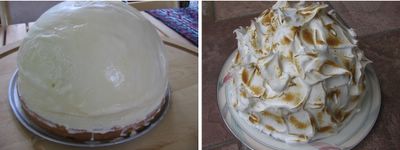Baked Alaska with Peach Sorbet

I made this dessert for a Turkish blog-event featuring Peach recipes. The preparation is somewhat involved, but those of you who do not have to rush like me to meet a deadline can plan it over several days, and actually have fun making it.
I always wanted to make a baked Alaska, although the thought of using raw egg whites for the meringue topping kept bothering me. So, when I found out a few days ago that you can actually cook your meringue, I knew that it was time to try this classical summer dessert.
The Italian meringue took quite long to make, but otherwise, no difficulties were encountered during preparation. My Chef's torch came in very handy both to remove the frozen ice cream from the bombe mold and to finish off the cake. (However, I realized later that it may be even easier to line the mold with plastic wrap, so that's how I wrote down the recipe.) The result was definitely more than the sum of its parts, a refreshing dessert with a nice presentation.

- 8" cake layer for base (recipe below)
- 1 3/4 qt vanilla ice cream, softened
- Peach sorbe, softened (recipe below)
- Handful of shelled pistachios or almonds
- Italian meringue topping (recipe below)
Place your cake layer on a baking sheet. Remove the ice cream from the freezer and invert the mold over the cake. Keep covered with plastic wrap and return to freezer.
Shortly before serving, preheat the oven to 425F. Take the cake out of the freezer and remove the wrap. Cover it completely with Italian meringue making sure that no ice cream is visible. Bake until the meringue is nicely colored. This should not take more than a couple of minutes. You can also use your kitchen torch like I did. But be more patient than me and keep at it to get a nicely browned topping.



















<< Home